#holocephalan
Explore tagged Tumblr posts
Video
youtube
Restless flounders, graceful chimeras, and playful sea lions await you in this short compilation of aquarium footage from PDZA.
#pdza#point defiance zoo & aquarium#starry flounder#platichthyes stellatus#hydrolagus colliei#spotted ratfish#chimera#california sea lion#zalophus californianus#pinniped#flatfish#pleuronectodae#holocephalan#marine biology
3 notes
·
View notes
Text
The fossil, from a genus called Iniopera, is the only suction feeder to be identified among chimaeras, and quite different from living chimaeras, which feed by crushing mollusks and other hard-shelled prey between their teeth.
The study shows in their early evolutionary history, some chimaeras were inhabiting ecological niches that are now monopolized by ray finned fishes—a far cry from their modern life as specialized shell-crushers."
Because chimaeras' skeletons are composed mostly from cartilage, their fossil remains are often flat and therefore difficult to extract information from.
Evidence for high-performance suction feeding in the Pennsylvanian stem-group holocephalan Iniopera
Abstract
The Carboniferous (358.9 to 298.9 Ma) saw the emergence of marine ecosystems dominated by modern vertebrate groups, including abundant stem-group holocephalans (chimaeras and relatives). Compared with the handful of anatomically conservative holocephalan genera alive today—demersal durophages all—these animals were astonishingly morphologically diverse, and bizarre anatomies in groups such as iniopterygians hint at specialized ecological roles foreshadowing those of the later, suction-feeding neopterygians. However, flattened fossils usually obscure these animals’ functional morphologies and how they fitted into these important early ecosystems.
1 note
·
View note
Text
1) 400MYa is roughly when the class Chondrichthyes, of which the subclass holocephalan is under, became distinct from bony vertebrates.The spotted ratfish, as a species, absolutely has not existed for 400MY. 2) Both males and females occupy shallow waters. It’s one of the many details that make this species unique from other chimeras. They are a delight to behold if you dive in Puget Sound, most commonly seen in the Central Basin and up, at Three Tree Point, Elliot Bay, and KVI Reef.
3) H. colliei do have a venomous dorsal spine, but it is a defense mechanism. They are slow animals, and will slowly make their way away from you if they’re uncomfortable, but I’ve never seen them charge at any individual who is not conspecific. A harbor seal once washed up in Puget Sound dead, and an autopsy reported that the cause of death was ingestion of a spotted ratfish. Think of them like poison dart frogs; they are poisonous, but that poison is a last-resort. Fighting larger animals is just nut their cup of tea, but a fatal surprise awaits anything trying to eat them. Both males and females have this dorsal spine, and both react similarly to your presence.
Animal of the Day!
Spotted Ratfish (Hydrolagus colliei)
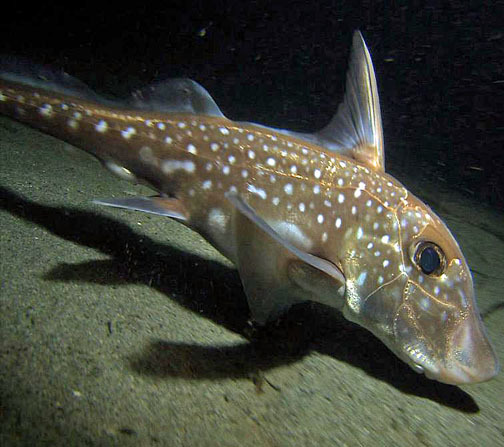
(Photo from Aquarium of the Pacific)
Conservation Status- Least Concern
Habitat- Eastern Pacific Ocean
Size (Weight/Length)- 90 cm
Diet- Small fish; Crustaceans; Shellfish
Cool Facts- With fossil records going back 400 million years ago, the spotted ratfish lived before land plants even existed. The majority of their lives are spent wandering the ocean floor almost 900 meters down. Using their sensitive snout, spotted ratfish search for anything that can fit in their mouths. During their spawning seasons, females travel to shallower waters to lay a dozen egg sacks in the sand. Once the deed is done, mom leaves the eggs. Due to their plant-like appearance, the eggs are generally undisturbed for the entire year it takes to hatch. Spotted ratfish are generally shy and prefer running to confrontation. However, some larger females are willing to chase people from their territory using a venomous spine on their dorsal fin.
Rating- 13/10 (Was around before and after the dinosaurs.)
Requested by @keaneblr
357 notes
·
View notes
Text
Fish Facts #10 Deep Sea Chimaera
In Greek mythology the Chimaera was a monstrous fire breathing hybrid of a lion, a goat, and a snake for a tail. However the real Chimaera might seem even more strange to some. Some alternative names you might know them by are ghost sharks, ratfish, or rabbitfish.
The chimaera are primarily deep sea fish who’s body lacks a skeleton but is made up of cartilage, similar to sharks, they have been found in waters around 1,000 feet (305 meters).

Instead of having pointed teeth it has 3 pairs of crushing plates similar to a ray’s and the general shape of it’s body reminding people of a shark, those animals being its closest living relatives.

For an adult chimaera its size can vary from 60 cm (2 feet) to 200 cm (6.5 feet), fairly small compared to most other deep sea creatures.
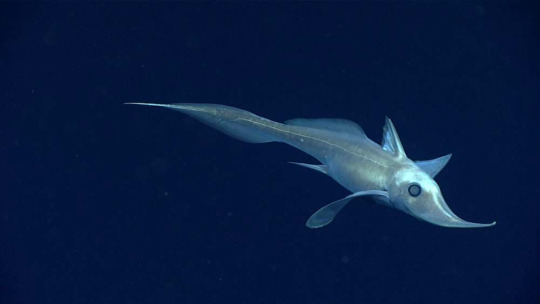
Those peculiar dots on its face are sensory organs which a large majority of fish have and are scaleless.
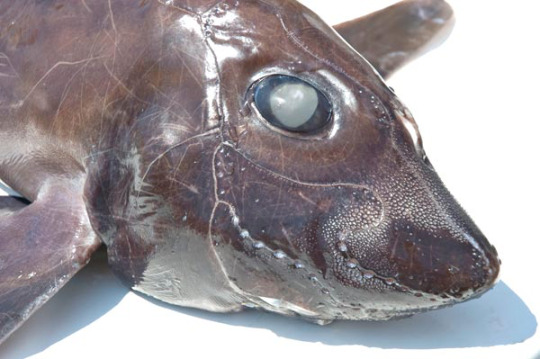
Although their gills are not visible, they do have them! The four gills are hidden by a sort of flesh curtain called a Operculum. The holocephalans are the only group of fish that possess true nostrils. Respiratory water is drawn in through the “nostrils” and passed over the gill arches.
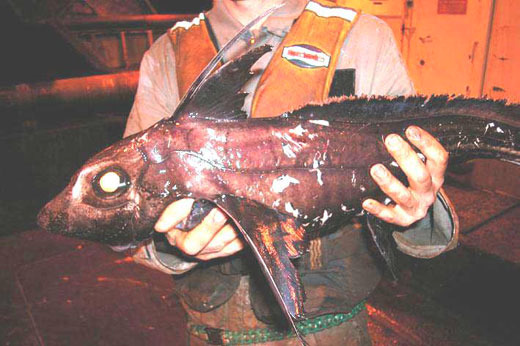
They also swim primarily with their large side pectoral fins instead of their tail like sharks do, making them akin to ocean birds.

These fish belong to subclass Holocephali, which is over 420 million years old but despite being that old there are more than 50 species living today. Also here is a wacky tidbit, Holocephali translates to whole head in latin!

The exposed mouth of a plough-nose chimaera, which ses its snout to probe the sediment in search of food. It's nostrils are also visible in this image.
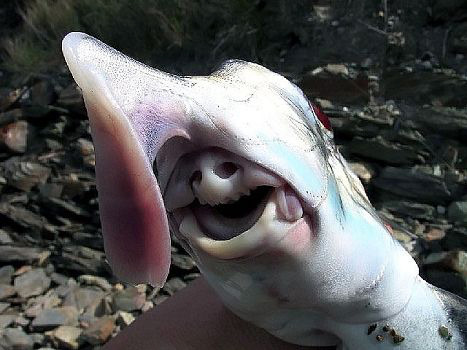
They also a carry toxic spine in front of their first dorsal fin to protect from any attacks. Although definitive proof of spine toxicity is lacking in the literature, medical reports suggest fishermen have experienced burning and numbing sensations for weeks after puncture traumas from chimaera spines. (I did find a couple medical journal pertaining to the injuries, please let me know if you would like to read it and I will be glad to share!)

youtube
youtube
youtube
#fish#fun facts#interesting facts#marine biology#marine life#sea creatures#fishes#animal facts#random facts#miscellaneous facts#Youtube
1 note
·
View note
Photo

Edestus, a holocephalan fish from the Late Carboniferous (~315-299 mya) of Eurasia and North America. A relative of the “spiral-saw-mouthed” Helicoprion, it continuously grew a single row of teeth in each jaw, creating an arrangement often compared to a pair of pinking shears.
Multiple species of this genus have been named, with varying degrees of tooth bracket curvature, and the largest may have had body sizes similar to modern white sharks -- about 6m long (19′8″).
Since Edestus is only known from fossilized tooth brackets, how exactly its jaws worked and what it ate with them is still a mystery. Many reconstructions end up either goofy or horrifying as a result, and so I’ve attempted to make this one look a bit more “normal”. And capable of closing its own mouth.
#science illustration#paleontology#paleoart#palaeoblr#edestus#scissor-tooth shark#edestidae#eugeneodontida#holocephali#chondrichthyes#fish#art#go home evolution you're drunk#seriously what's with all the HORRIFYING PROTRUDING SKINLESS JAWS?
177 notes
·
View notes
Text
ok but. holocephalans do have denticles. along the lateral line canal, sometimes on the back esp in youngsters, and on the head and pelvic claspers! here's some pictures of them from a dissection i did of a Hydrolagus - left from the rim of the lateral line, right from a pelvic clasper.

Fossil holocephalans have even more and weirder denticles - see the spine brush complex & top of the head of Carboniferous holocephalans like Akmonistion or Stethacanthus:

Even Cladoselache, one of the best described early symmoriform holocephalans (close the the elasmobranch-holocephalan split) had denticles along the fin edges and lateral line. Point is, it goes deep. The common ancestor of elasmobranchs and holocephalans most likely had denticles, and their distribution was reduced (or lost, in some cases) in the chimeras. They don't look like your average selachian ("true shark") denticles:
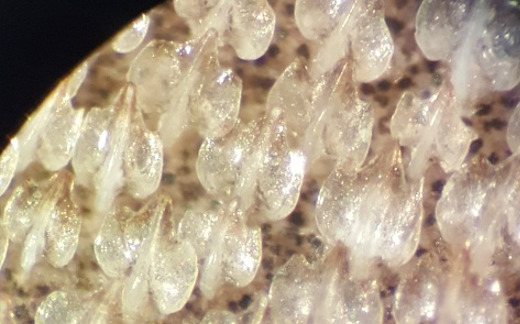
but that's ok. denticles come in all shapes & sizes :3
Daily fish fact #402
Chimaeras!
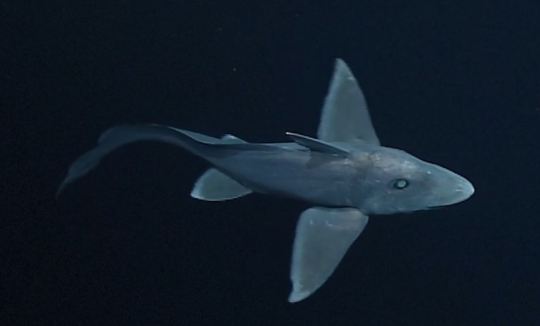
Also called ghost sharks. They have interestingly lost the scales other sharks have, also known as denticles! Juvenile chimaeras have denticles on their back, but they lose them as they age.
848 notes
·
View notes
Text
The unique uterine structure of the basal monogenean Chimaericola leptogaster (Monogenea: Polyopisthocotylea), an ectoparasite of the relictual holocephalan fish Chimaera monstrosa
Abstract
Ultrastructural studies of the monogenean uterus are few in number and no non-polystomatid polyopisthocotyleans have been investigated. The uterus of Chimaericola leptogaster, a basal polyopisthocotylean monogenean, has several unusual features, including six reflexed loops comprising four ascending and three descending, longitudinally oriented, linear sections. At the ultrastructural level, three readily distinguishable uterine regions and other distinctive characteristics are apparent. One novel feature occurs in the proximal uterus, where the lining forms a so-called ‘single-layered multi-rowed cellular epithelium’, which includes two types of cells, tall (ca. 14–19 μm in height) and short (ca. 6–9 μm in height) cells, both lying on the basement membrane. Although known from other bilaterian groups, this is the first record of this type of epithelium in the Neodermata. The lining of the middle uterine region comprises a single regular layer of columnar glandular epithelial cells, which produce numerous rounded, electron-dense granules associated with Golgi complexes. The presence of the uterine glands in the middle region of the uterus is an unusual feature for a monogenean, having previously been described only for basal orders of the Cestoda, i.e. the Gyrocotylidea, Caryophyllidea and Spathebothriidea. Seen in cross-section, the epithelium of the distal uterus contains three areas of tall single-layered columnar epithelium (ca. 30 μm deep) interspersed by three areas of flattened epithelium (ca. 0.2–0.9 μm deep). Such a pattern is quite different from those reported for other monogeneans and, indeed, other neodermatan groups. The investigation has shown that the outer layer of the fully formed eggshell is assembled from epithelial secretions in the middle uterine lumen, but is modified in terms of its shape in the distal uterus. Possible phylogenetic implications arising from the unusual features described are discussed in relation to other neodermatan groups and recent molecular phylogenies of the Bilateria.
from #ORL-Sfakianakis via xlomafota13 on Inoreader http://ift.tt/2wyx1I8
from OtoRhinoLaryngology - Alexandros G. Sfakianakis via Alexandros G.Sfakianakis on Inoreader http://ift.tt/2vFTbfd
0 notes
Text
She's adorable! And also, she's not "the chimaera," she is just one species in an entire sub-class of the chondrichthyes (cartilaginous fish).
All sharks and rays are in the sub-class elasmobranchs (five+ gilled), all chimaeras and ratfish are in the holocephali! It's an entire new branch at the root of just having no bones and being a vertebrate!
These beautiful, majestic, and graceful animals only has one pair of gills and use their pectoral fins to swim. Their mouths and nostrils are on the bottom of their head, yet they possess a laterally compressed body scheme and a long tail. Other than cartilage, another universal feature they share with sharks and rays (and skates!! Don't forget the sea napkins) are claspers on males! Yep, same reproductive hardware, for the most part. In the spotted ratfish, Hydrolagus colliei, the males have an appendage on their forehead called the tentaculum that serves to role of the mouth in sharks: it's used to hold onto the female's pectoral fin. Neat!
I can't say for certain if all holocephali have a tentaculum, but considering their similar build, it's likely!
The famous prehistoric chondrichthyes, helicoprion, was a holocephalan! It had one pair of gill slits, despite it's sharky appearance. One of the things it shared with modern holocephali was fused teeth. Neat!!
While most holocephali dwell too deep for human contact, the spotted ratfish love to spend time in shallower water, so if you are a diver, you can often see them in the NE Pacific. And if you are an aquarium connoisseur, they can be found at the Seattle Aquarium, the Point Defiance Aquarium, and the Oregon Coast Aquarium!
Cheers.
The Chimaera. A deep sea cousin of the shark that looks like a some kind of Halloween monster.



761 notes
·
View notes
Text
On Helicoprion's Pelvic Fins (or lack thereof)
For about a year, now, I've been wracking my mind on the subject of the latest reconstruction of the extinct holocephalan[1] Helicoprion[2]. By all other accounts the latest reconstruction, which can be viewed below, is the best it's ever been. The iconic Eugeneodontid[3] tooth whorl fits into the jaw in a logical way and lends credence to our present understanding of its diet.
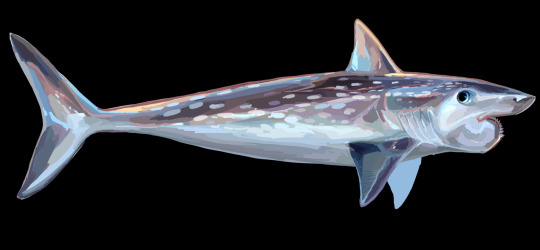
But, as you gaze further posterior, you may notice something queer: no pelvic or anal fins. Now, a not-insignificant number of living chondrichthyes[4] lack anal fins. This is not out of the realm of imagination. But the same cannot be said of the pelvic fins, which aid in control and stabilization and also serve as the girdle for which claspers are attached to in males. All living chondrichthyes possess pelvic fins; from chimaeras like Hydrolagus colliei[5], to sharks like Hexanchus griseus[6], to skates[7] like Raja binoculata[8].
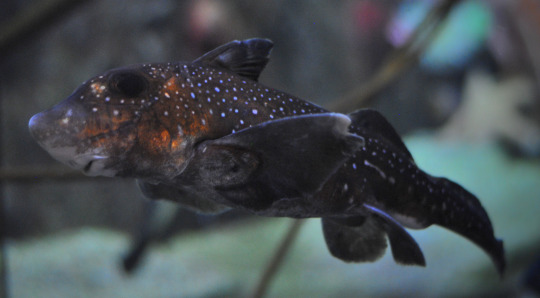
(Hydrolagus colliei)
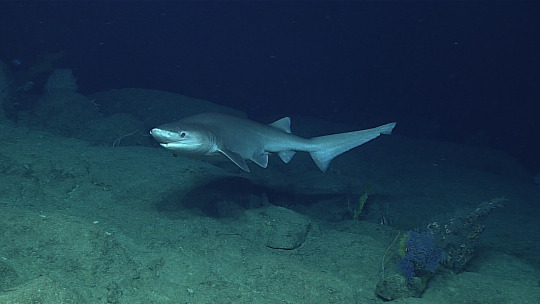
(Hexanchus griseus)

(Raja binoculata)
So, why are they missing in our latest reconstruction? I made attempts last year to reach out to the researcher responsible for our modern understanding of Helicoprion, Jesse Pruitt (whose lecture on his research set me off on this journey), through LinkedIn, but I never got a response. Looking through my message history, though, the conversation appears to have disappeared, making me wonder if I'd actually sent it at all.
This morning, I tried again. I drafted up my question and reasoning and sent it to Pruitt's LinkedIn and ResearchGate profiles, and I sent it to the Idaho Visualization Laboratory (IVL) which made the Helicoprion model. I had expected considerable delay, but to my mirth, I got a response this afternoon.
On behalf of IVL, Leif Tapanila responded to my email with answers. As it were, other Eugeneodontids from the Carboniferous and Permian periods were preserved better than our Helicoprion specimens. Specimens of Fadenia[9] and Romerodus[10] were preserved very well with full-body imprints in consistent shale rock.

(Fadenia)

(Romerodus)
These imprints lack pelvic fins. Considering their close relation to Helicoprion, this absence was assumed for the visualization. I've inquired after Edestus[11], another Eugeneodontid of the same era, since there are many specimens and imprints, however fragmentary. I have yet to receive an answer, but when I do, I will update this post.

(Edestus)
I was determined to find some oversight, since holocephalan specimens from the Devonian period include pelvic fins in their reconstruction, but it seems the facts have dissolved my suspicions. I wanted to share this with you all, since I cannot edit Wikipedia articles (much to my dismay, as I have learned much and more in my studies of H. griseus that I want to add to its page). This knowledge deserves to be shared, since I find it ponderous.
Until next time,
[1] Subclass of chondrichthyes, containing contemporary chimaeras.
[2] Extinct eugeneodontid. Etymology translates to "Spiral saw"
[3] Order of holocephalan characterized by tooth "whorls" and inability to shed teeth.
[4] Class of chordate (vertebrate) characterized by a cartilaginous skeleton
[5] Chimaera known as the "spotted ratfish"
[6] Hexanchiform known as "bluntnose sixgill shark"
[7] Order of elasmobranch "Rajiformes," adjacent to rays.
[8] Rajiform known as "big skate" (no, really. haha)
[9] Eugeneodontid from the Carboniferous, Permian, and Triassic period
[10] Eugeneodontid from the Carboniferous period
[11] Eugeneodontid from the Carboniferous period characterized by its scissor-like teeth and jaws.
#helicoprion#edestus#romerodus#fadenia#holocephalan#chimaera#chimera#chondrichthyes#eugeneodontida#jesse pruitt#idaho state university#idaho visualization laborator#ivs#paleontology#marine biology#fish
93 notes
·
View notes
Text
Obituary: Renae the Ratfish
I bring heartbreaking news from the aquarium, friends. I finally got ahold of a staff member who knew all the goings on, and after asking him where the other spotted ratfish (Renae) was, he informed me that she died two months passed. One of her favorite spots was near an exhaust vent, the grate of which collapsed, and she was sucked in. I didn’t know how to react, immediately, upon hearing this tragic news; but I cried for several minutes in my car, later.
Renae’s sister, Raechel, now flies about the tank alone. She appears more restless and agitated now that her sister is gone. She will be missed.
You’ve all seen her pictures and videos on my blog recently, but I would like to add my favorite photo of her on this post. The tears are coming on again.

I’m going to miss you so much </3
#renae#spotted ratfish#hydrolagus colliei#chimaera#obituary#chondrichthyes#holocephalan#fish#ghost shark#rabbitfish
4 notes
·
View notes
Photo
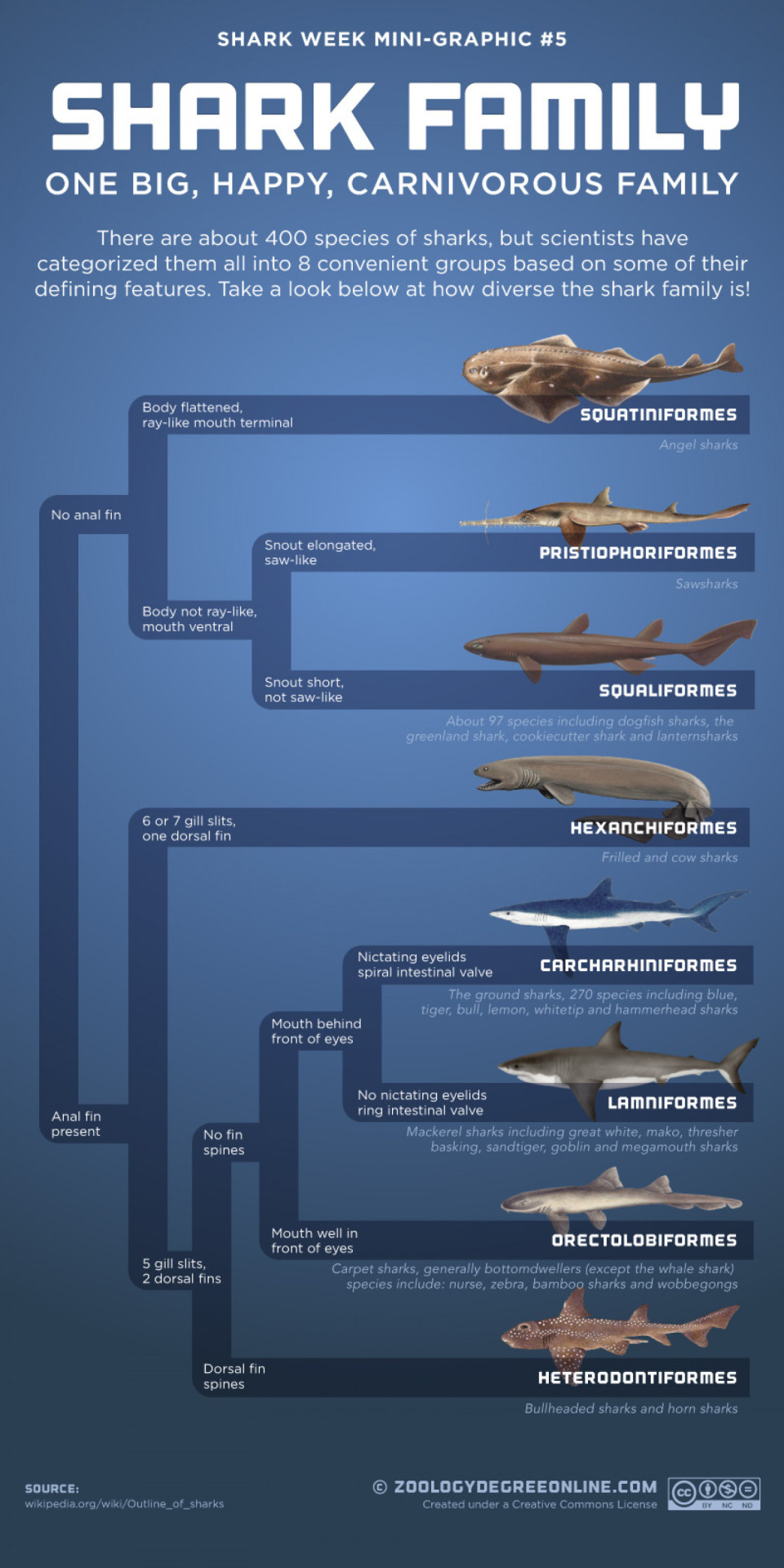
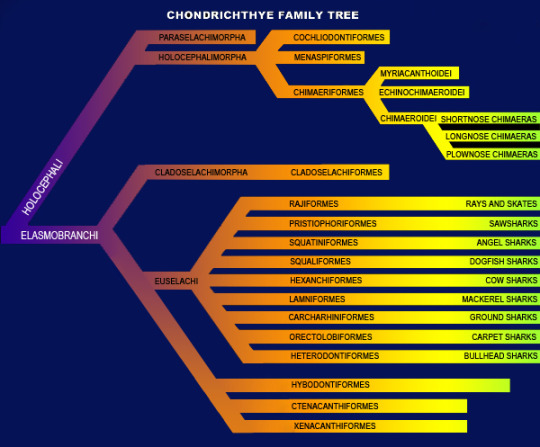
Here is a taxonomy bracket that I use to help me with shark species categorization and relatedness. The top image is specific to sharks and features images as well as brief descriptions and the criteria for each branch. The bottom image is expanded to include holocephalans (chimaeriformes), as well as skates and rays. Basically, everything under “chondricthyes”
#marine biology#ichthyology#chondrichthyology#chondrichthyes#holocephali#elasmobranchi#sharks#skates#rays#chimaeras#fish#taxonomy
21 notes
·
View notes